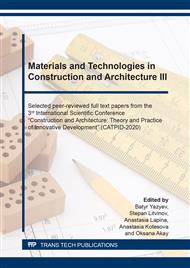p.1
p.8
p.14
p.23
p.31
p.37
p.44
p.52
p.59
The Cement Mechanical Activation Effective Application Field Determination
Abstract:
Of all the known methods for increasing the cement activity, mechanical grinding is distinguished in the work. For mechanical grinding, technological characteristics of grinding in an electromagnetic field are established (mill - linear induction rotator, LIV). The value of the increment of activity is determined depending on its initial (initial) value. To determine the estimated value of the cement consumption, the methods provided by the state standard of the Russian Federation were used. The experiments, as well as the measurement of the compressive strength (R), were carried out in accordance with the GOST requirements. The cement mechanical grinding effective application field in electromagnetic field is determined by comparing the costs and savings. The costs are calculated as the cost of electricity needed for grinding. The savings are the cost of the established difference between the cement consumption for the initial activity of cement and the actual value, which is able to provide the concrete with a given design strength. The results describing the field of the cement mechanical grinding effective application are presented in tabular form and graphically. When determining the area of the mechanical grinding effective use, the conclusion that it is necessary to adjust the technological grinding regimes depending on the initial activity of the cement, as well as on the chemical composition of the clinker (manufacturer) was confirmed. The prospects for the research on mechanical grinding technology are associated with obtaining grinding regimes depending on the initial size and composition of the clinker. The area of effective application of mechanical activation should be determined each time depending on the physical and mechanical cement properties.
Info:
Periodical:
Pages:
31-36
Citation:
Online since:
September 2020
Authors:
Price:
Сopyright:
© 2020 Trans Tech Publications Ltd. All Rights Reserved
Share:
Citation:


